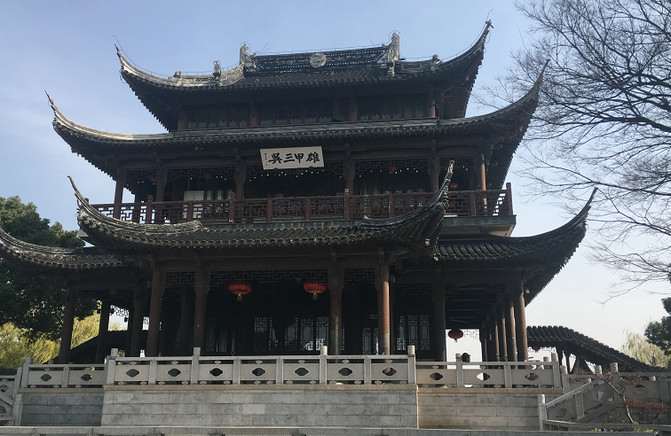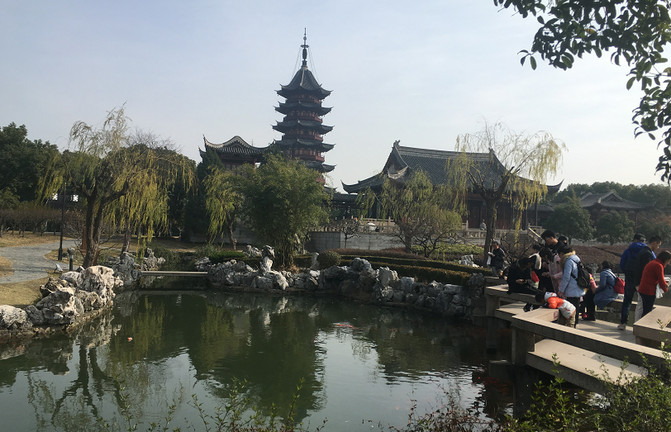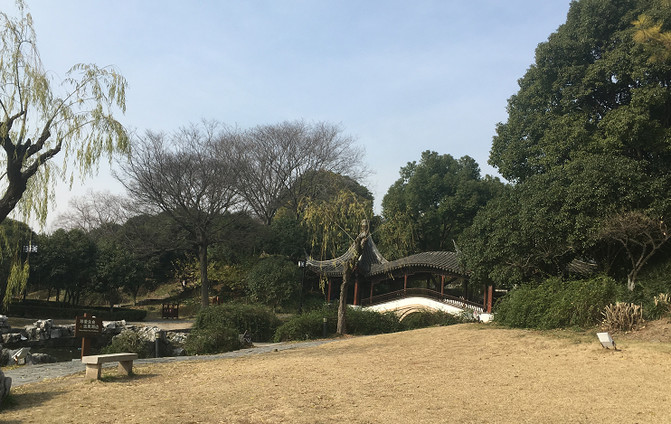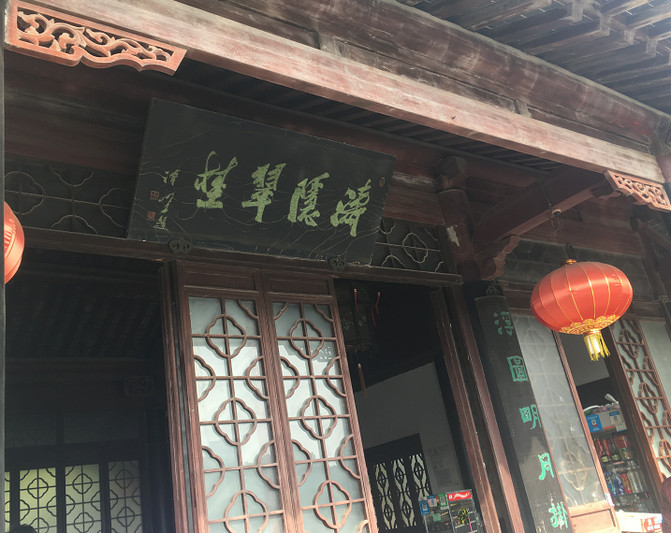Panmen, remembering the history of Wu and Yue at the gate of water and land (Part 2)
★ Tourist location: Suzhou Panmen Scenic Area
Walking out of the panmen, you will find Wuxiang Temple opposite you. The door is very small and looks like it should be a back door or something. Walking in, I knew that what I expected was good. Wu Xiangci's door appearance was quite grand. After all, Old Mr. Wu Zixu was the founder of the ancient city of Suzhou!

The camellia flowers in the yard bloom very well. They are not afraid of the cold. The colder they become, the more beautiful they become, and their appearance is beautiful. It seemed like he was old and tough like the Wu Zi he worshipped.

The statue of Wu Zi sitting in the temple is wearing a Chu colored robe and a bright yellow cloak. This statue was also built later. Bright yellow, a color that was later extremely noble, may not have existed in the Spring and Autumn Period.
Wu Zixu is a famous member, also known as Zixu, and the second son of Wu She, a doctor of Chu. In 522 BC, Wu She was killed, and Wu Zi entered Wu through Song, Zheng and other countries. He helped Helu, King of Wu, seize the throne. In the sixth year of King Jing of Zhou, he built Helu City, which is today's Old City of Suzhou. The monarch and minister assembled the army and practiced martial arts, and the state of Wu became increasingly powerful. Later, when he invaded Chu, Wu Zi took revenge and

After He Lu's death, his son Fuchai succeeded to the throne. At that time, Wu Zi had advised him to refuse the peace of Yue and stop going north to attack Qi, but he was gradually alienated by the ambitious and headstrong Fuchai. Later, this great hero of the State of Wu committed suicide and died. Suzhou local chronicles record: "Zixu died, and his body floated on the river. Fu Chai regretted it and set up an altar with his ministers on the river. The people built temples for it." Of course, everyone knows the history behind. Gou Jian, King of Yue, endured hardships and tasted courage and finally destroyed the State of Wu. Presumably, when the country was destroyed and the family was destroyed, Fuchai's remorse became even more overwhelming, right?

The current Wu Xiang Temple, also known as Wu Zixu Temple, was renovated in 1988, and this statue of Wu Zixu was rebuilt in 1996. His beard and hair are brown and his hair is white. Logically speaking, most people have white beards and hair, but Wu Zi turned white overnight, so he could only say that his hair was white.

The imitation bronze mural of "Wu Yuan Running to Wu" uses simple and concise techniques to show the story of Wu Ziken running to Wu. Wu Zi escaped from Zhaoguan and crossed the Yangtze River to the State of Wu. He lived on the streets, playing flute and begging in the market. Gongzi Guang took him in and put him in an important position. He planned to send warriors to assassinate the King of Wu with a Yuhidden dagger. Gongzi Guang won the throne and was known as Helu, King of Wu. This King of Wu was also a talented and ambitious man, and he valued Wu Zixu highly. It was only when his monarch and his subjects met each other that the State of Wu was strong in troops and horses, and dominated the various countries of the Spring and Autumn Period. Of course, the monarch and his subjects each got what they needed. King Helu of Wu used Wu Zi to complete the hegemony of the Spring and Autumn Period, while Wu Zi used the power of Wu to avenge his father's death. The murals depict the plots of "Zhaoguan White Hair","Desperate to Wu" and "Zhuan Zhu Assassination of Officials" respectively, which can also be regarded as a portrayal of Wu Zi's life.

Walking on the process bridge, there is a stone clip, which is called the "Millennium Stone clip". This stone is a relic of the Wuxiang Temple in the early Song Dynasty discovered during the restoration of Panmen Scenic Area. It has a history of more than a thousand years from the Song Dynasty to today, so it is no exaggeration to call it a "thousand-year-old stone". This stone is a stone tablet standing opposite each other, commonly known as the flagpole stone. A pole is standing between the two stones. It is used to hang flags during the day and long-life lanterns for illumination at night.

There is a wide Bibo Bridge over there that leads to the Shuilian Cave. Ahead is Lvping Square, also known as the International Garden. It displays gifts from some foreign cities that have become sister cities with Suzhou, such as the Gondola in Venice, Italy, the Portland Lodge in the United States, and the Sailing Sailboat Konstanz in Germany.

Although the ship is not large, the gondola should be regarded as one of the most famous ships, and its image has even become a symbol of Venice. This unique little boat is eleven meters long and weighs 600 kilograms. It can be rowed by one person and one oar. It is built of eight different types of wood, and the only metal components are decorative combs and curls on the bow and stern. In other words, if there are no ornaments, it can actually be without metal components, right?

Lijing Tower is the three-story attic we saw in Sirui Hall and Bell and Drum Tower. Although it looks majestic at close up, people do hang the plaque of "Xiongjia and Three Wu" impolitely, but it looks like it is newly built. There are no historical relics for people to rely on, and it is not open to itself.

On the other hand, the platform in front of the building is connected by two small bridges and protrudes into the center of the lake. It is called "Penglai on the Water". Such a small scene naturally cannot be compared with the real Penglai. It just means being in the water, and it can be regarded as very suitable for the scene.
Walking back to Lijing Building, there is a Tai Chi Free Life Pond in the northwest corner of the scenic area. However, because there are no temples nearby, there are probably not many citizens who will come to release the animals.

On the edge of the lawn are Ridao and Yuedao, which are actually two circles, but one is paved with dark red tiles and the other is paved with gray bricks. There is no special meaning in itself, but the children happily jumped from Japan Island to Moon Island, and then from Moon Island to Japan Island, and had a lot of fun.

The double pavilion covered bridge is very long, and seems to echo the "Yisheng" corridor on the other side. The two pavilions are not together, one at the foot of the mountain and the other at the top of the slope. Call it a slope, but it's really just a very low slope.

Tao Yin Cui Villa protrudes into the lake. Its name is really beautiful and fascinating, but it is actually just a canteen selling small things.
Connecting Cuishu is a folded bridge, which is very small. There are also many koi carp raised in the small pool by the bridge. The scenery here is also good, but the temperature is a bit low, otherwise you can still play in the water.

Tang Well was discovered during the renovation of Ruiguang Tower in 1984. It is 50 centimeters above the surface. According to research, it may have been the living well of the monks of Puji Temple (Ruiguang Zen Temple) at that time.

Because I was thinking about the Wumen Bridge outside Panmen Gate, although I turned around and returned to the east gate of Panmen Scenic Area, I still walked back to the south gate very persistently.

Wumen Bridge was built in the seventh year of Song Yuanfeng. It was called the "New Bridge" at that time because the completion of this bridge ended the history of Panmen Ferry. The river surface here is relatively wide, and perhaps the technical conditions at that time were not enough to build a frame bridge, so the bridge consisted of two wooden bridges connected on the north bank and a stone bridge on the south bank. It was also called the "Three Bridges" at that time. During the Southern Song Dynasty, the three bridges were converted into three-hole stone arch bridges and renamed Wumen Bridge. The single-hole stone arch bridge was rebuilt in the Qing Dynasty, built of Suzhou Jinshan granite, mixed with a small amount of Wukang stone left over from the old bridge in the Song Dynasty.

The bridge body has a total length of 66.3 meters, a medium width of 4.8 meters, a clear span of 16 meters, and a total height of 11 meters from the water plate stone surface to the top of the bridge railing. The north and south slopes have 50 steps, which are paved with a whole piece of stone.

There is also a Shuiguan Bridge next to it, which looks like it is old, but there is no introduction to it, so it may not be as old as Wumen Bridge. Moreover, this type of bridge is not uncommon in Suzhou, unlike the title of Wumen Bridge. There is the word "most" in the head. The most famous one in Suzhou is undoubtedly Maple Bridge, which is famous for the poem "Maple Bridge Mooring at Night" written by a poet of the Tang Dynasty; the oldest one is Wuque Bridge, which was built at the same time as Helu City; the longest one is Baodai Bridge, which is the longest porous stone arch bridge among ancient bridges in my country. The Wumen Bridge is the highest bridge in Suzhou and is naturally famous among bridges in Suzhou. Therefore, together with the Shuilu Gate and Ruiguang Tower, it is also called the "Three Scenes of Panmen".

The original Wumen Bridge was located in the Golden Waterway, where blockages often occurred. There were "big blockages, small blockages occurred every day." There were also serious shipwrecks, and the canal was suspended for 12 days. In order to protect this Wumen Bridge, the Grand Canal was diverted to avoid the moat, and the Wumen Bridge became more of a landscape bridge. There are still a few boats in the river today, which seems to be cruise ships.

Next to Panmen is a trail along the canal. Some people are walking and others are running. This road is a bit long, and I don't have time to go to the end. It looks like an ancient city. In fact, Suzhou City itself is an ancient city, and may also be the most successful city in China in preserving its old appearance. Walking on the streets of the city, you can also feel an ancient charm.


























Previous Article:2023 Nankun Mountain Natural Oxygen Bar Flower Tour and the 2nd Orchid Culture Festival Launched
Next Article:Double Festival Tour to avoid the peak crowd
